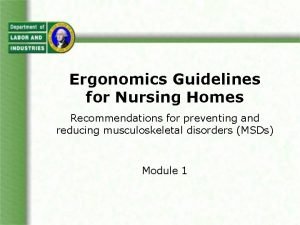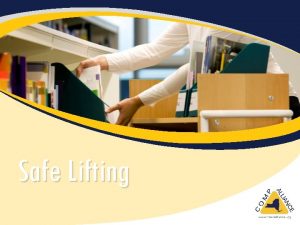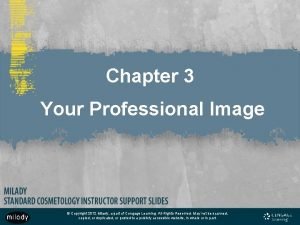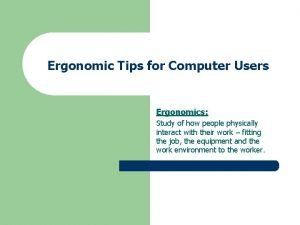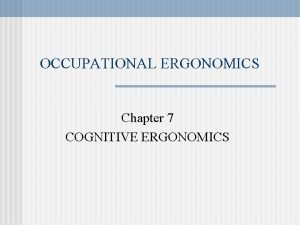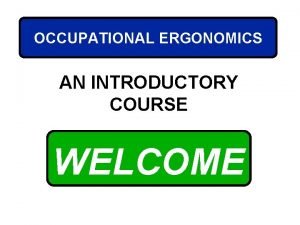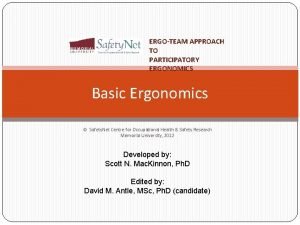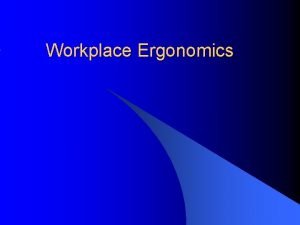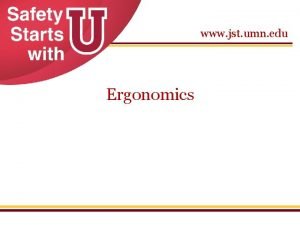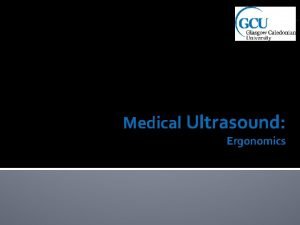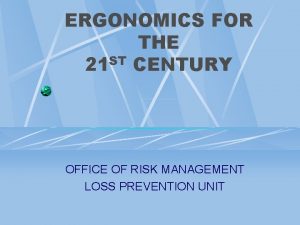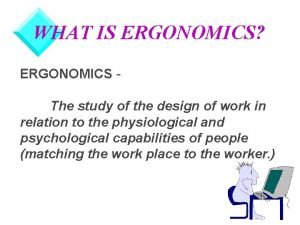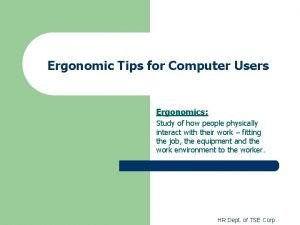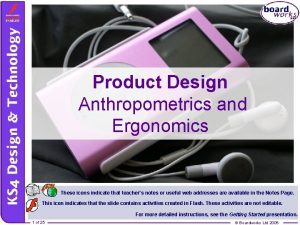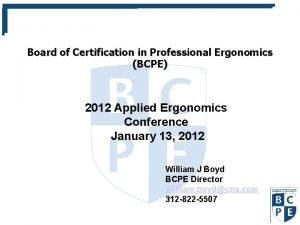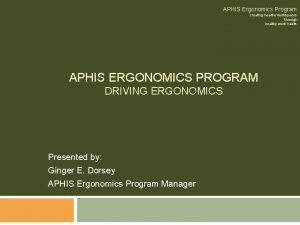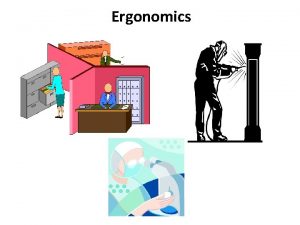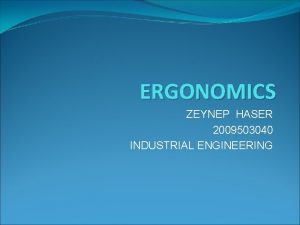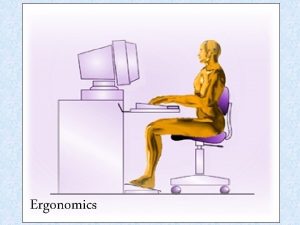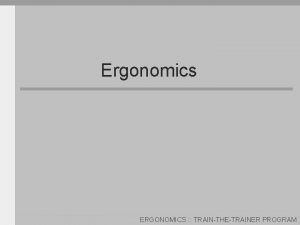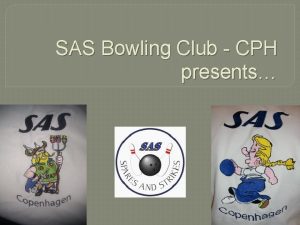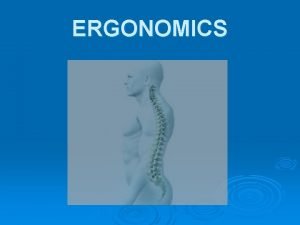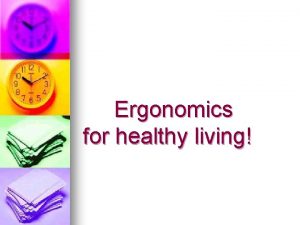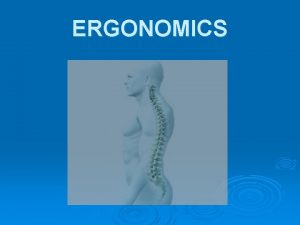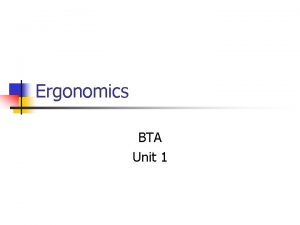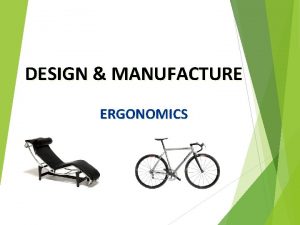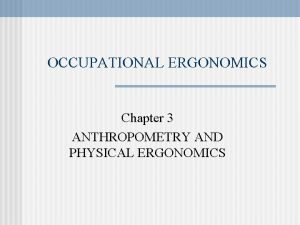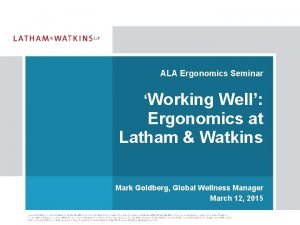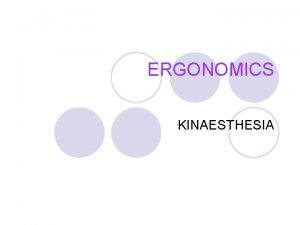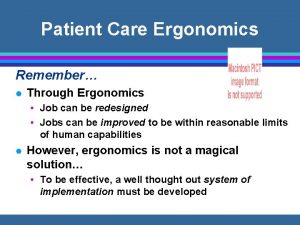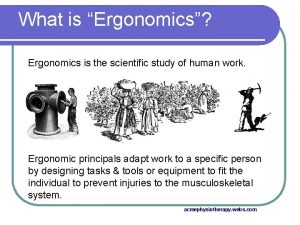Eduardo J SalazarVega MHP CPH Ergonomics What is

























- Slides: 25

Eduardo J Salazar-Vega MHP CPH Ergonomics


What is ergonomics � Ergo = work � Nomos = laws � It is an applied scientific/engineering discipline concerned with the interaction among systems and the people who operate and maintain them � OSHA defines it as “the study of the design of requirements of work in relation to the physical and physiological capabilities and limitations of people Whenever a human becomes part of the operation of a system, ergonomics become a necessary consideration

What is ergonomics? Physiology Medicine Engineering Ergonomics Behavioral Science Anthropometrics

Other Considerations Psychological factors –attitude, motivation Somatic factors –age, sex, health, size Physiological factors –fuel, oxygen Learning factors –training, knowledge, adaptability Nature of work –intensity, duration, rhythm, technique, position Environment –heat, cold, noise, altitude, pollution

Approaches Reactive ergonomics –corrective actions after the event occurs Proactive ergonomics –corrective actions taken before injuries and illnesses occur

Problems to solve Tool/product design Workplace Design Integration of new technology Environmental Conditions Materials handling Task/job design Workstation design The goal of ergonomics is to make the workplace as adaptable as possible to the people who will be working on it.

Common ergonomic issues Workstations �Control and display �Labels and location aids �Guarding and warnings �Hand tools �Machinery and design �Location and orientation of work equipment design surfaces �Size and shape of work �Posture/work height objects and reaches �Movements/repetitions �Weight of work equipment and objects �Vibrations �Accessibility

Common ergonomic issues Environmental Lighting/noise Temperature/humidity Housekeeping Hazardous materials

Role/benefits of ergonomics Benefits Manufacturing Measures Increased operator acceptance • Injury/illness frequency and associated costs • Worker’s compensation • Employee turnover • Employee absenteeism • Safety awareness Increased dependability or reliability • • • Scrap (error) rate Maintenance costs Machine up-time Logistic support Safety awareness Flexibility and adaptability to change • • Reprogramming time/cost Modifiability Part change Safety awareness Increased efficiency and productivity • Parts/hours (shift) • Scrap (error) rate • Safety awareness

Identifying ergonomics problems �Trends in accidents �Excessive overtime and increased work and injuries rate �Incidence of �Poor product quality cumulative trauma �Manual materials disorders handling and �Absenteeism, high repetitive motion tasks turnover rate �Employee complaints �Improperly designed workstations for �Employee-generated disabled people changes in the workplace �Incentive pay systems

Risk factors while manual material handling tasks Job �Weight �Location �Frequency/Duration �Stability �Grip �Workplace geometry �Environment Personal �Sex �Strength �Age �Fitness �Anthropometry �Lifting techniques and training

Data Collection General observations Questionnaires Interviews Video analysis Photography Drawing or sketching Evaluation of workers capabilities Measurement of various risk factors

General Observations – Repetitive Trauma Disorders �Awkward postures �Fit of work gloves �High task �Poor workstation repetition design �High force required �Hand tool fit �Mechanical stress �Vibration sources points �Cold temperatures

General Observations – Manual Materials Handling �Lifting from the floor �Lifting while twisting �Lifting heavy weights �Lifting bulky objects �Lifting repeatedly �Lifting above shoulder height �Lifting heavy items while seated �Pushing or pulling loads �Nature of hand holds �Storage methods �Parts staging �Floor condition in the work environment �Workstation layout �Conflicting movements �Poor posture �Bending

NIOSH Lifting Equations http: //www. cdc. gov/niosh/docs/94 -110/

NIOSH Lifting Equations (cont) Horizontal Distance (H) Vertical Distance (V) Vertical Travel Distance (D) Frequency of Task (F) Duration of Task Assymetry (A) Coupling (C) Weight of Load (L)

NIOSH Lifting Equations (cont)

NIOSH Lifting Equations (cont) �Recommended Weight Limit RWL = LC x HM x VM x DM x AM x FM x CM �Lifting Index LI = L/RWL

REBA/RULA �RULA: Rapid Upper Limb Assessment (Mc. Atamney & Corlett, 1993) �REBA: Rapid Entire Body Assessment (Hignett & Mc. Atamney, 2000)





Thank you!
 Cph exam pass rate
Cph exam pass rate Munitions history program answers
Munitions history program answers Junginger markus
Junginger markus Mhp associate partner gehalt
Mhp associate partner gehalt Ergonomics in textile industry
Ergonomics in textile industry Six pillars of ergonomics
Six pillars of ergonomics Ergonomics
Ergonomics Ergonomics lifting techniques
Ergonomics lifting techniques Professional image milady
Professional image milady Ergonomic tips for computer users
Ergonomic tips for computer users Wsfcs atkins
Wsfcs atkins Types of ergonomics
Types of ergonomics Objectives of ergonomics
Objectives of ergonomics Ergoteam
Ergoteam What is ergonomics
What is ergonomics Umn ergonomics
Umn ergonomics Ergonomics ultrasound scanning
Ergonomics ultrasound scanning Types of ergonomics
Types of ergonomics What is ergonomics
What is ergonomics Ergonomics tips for computer users
Ergonomics tips for computer users Ergonomics and anthropometrics
Ergonomics and anthropometrics Https://iehf.org/web-design-ergonomics-checklist/
Https://iehf.org/web-design-ergonomics-checklist/ Controller ergonomics
Controller ergonomics Driving ergonomics checklist
Driving ergonomics checklist Ergo nomic
Ergo nomic Define ergonomics in industrial engineering
Define ergonomics in industrial engineering






